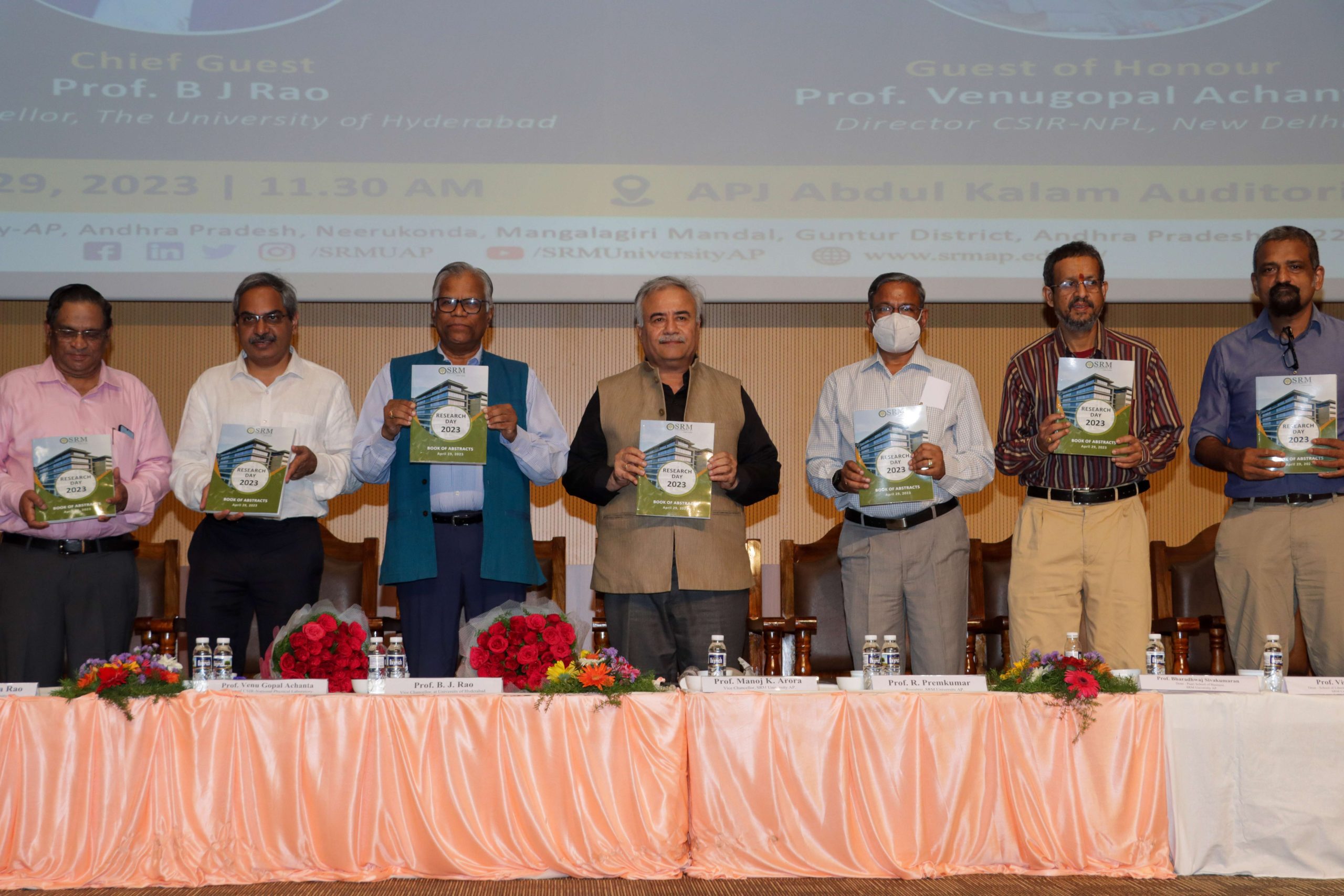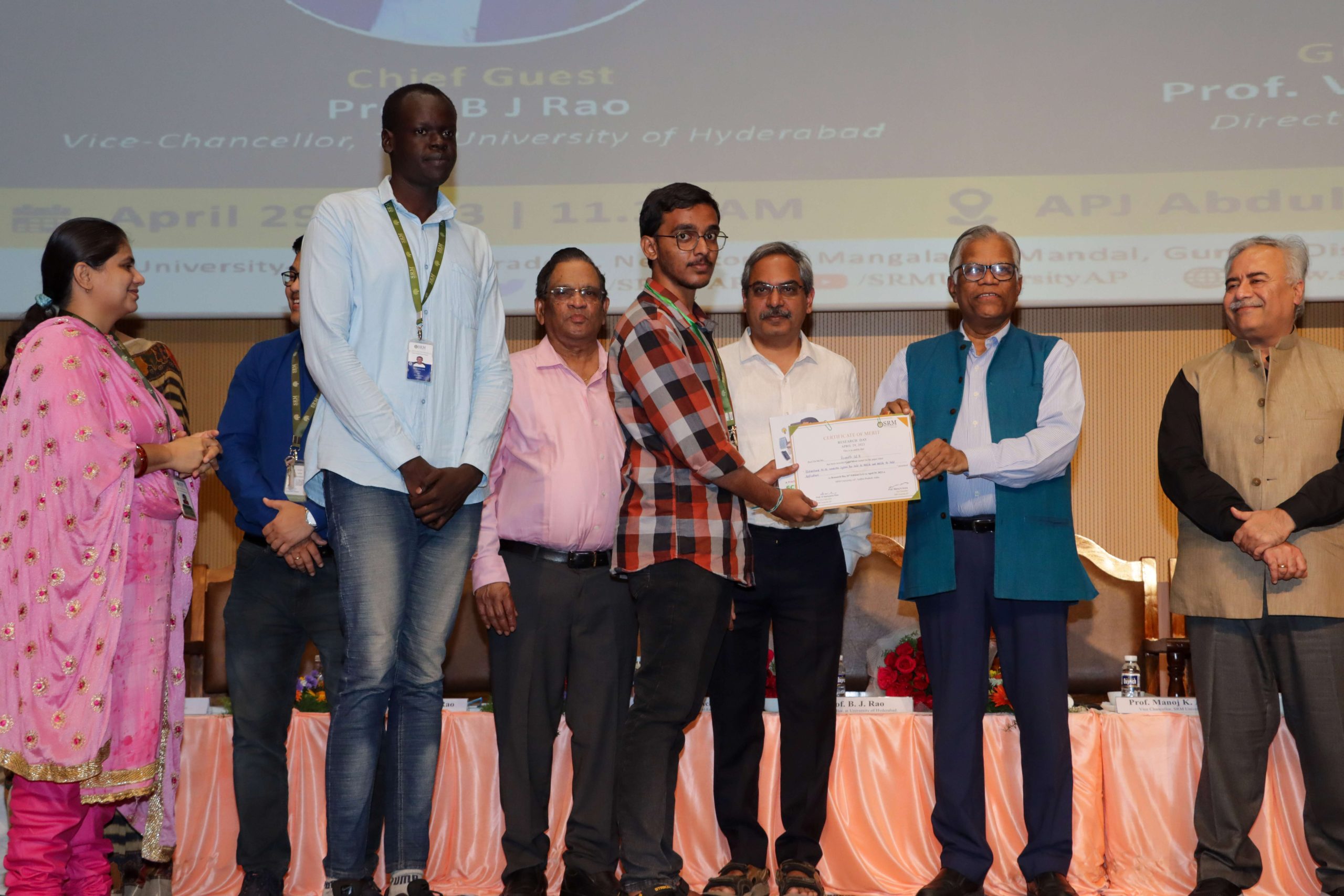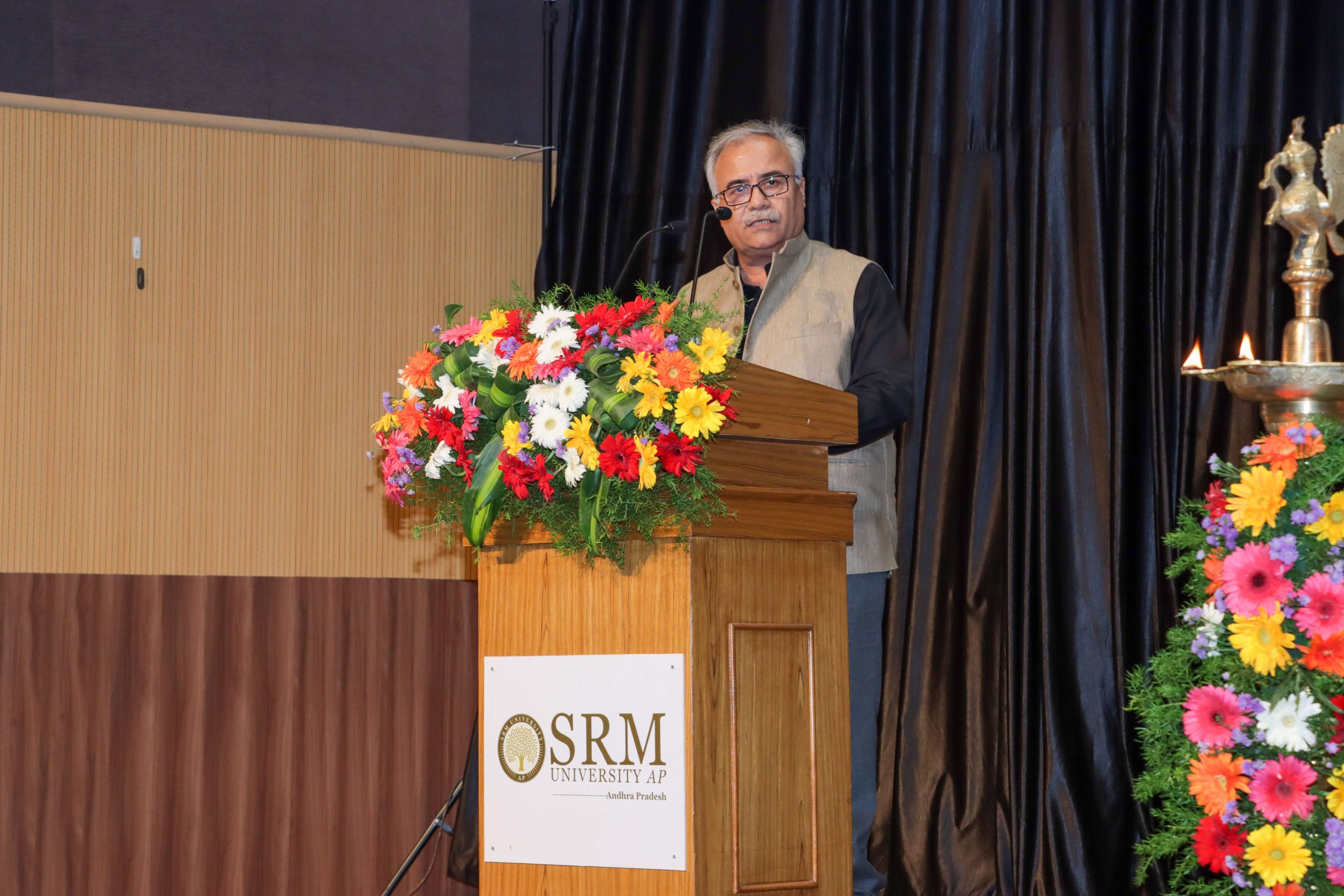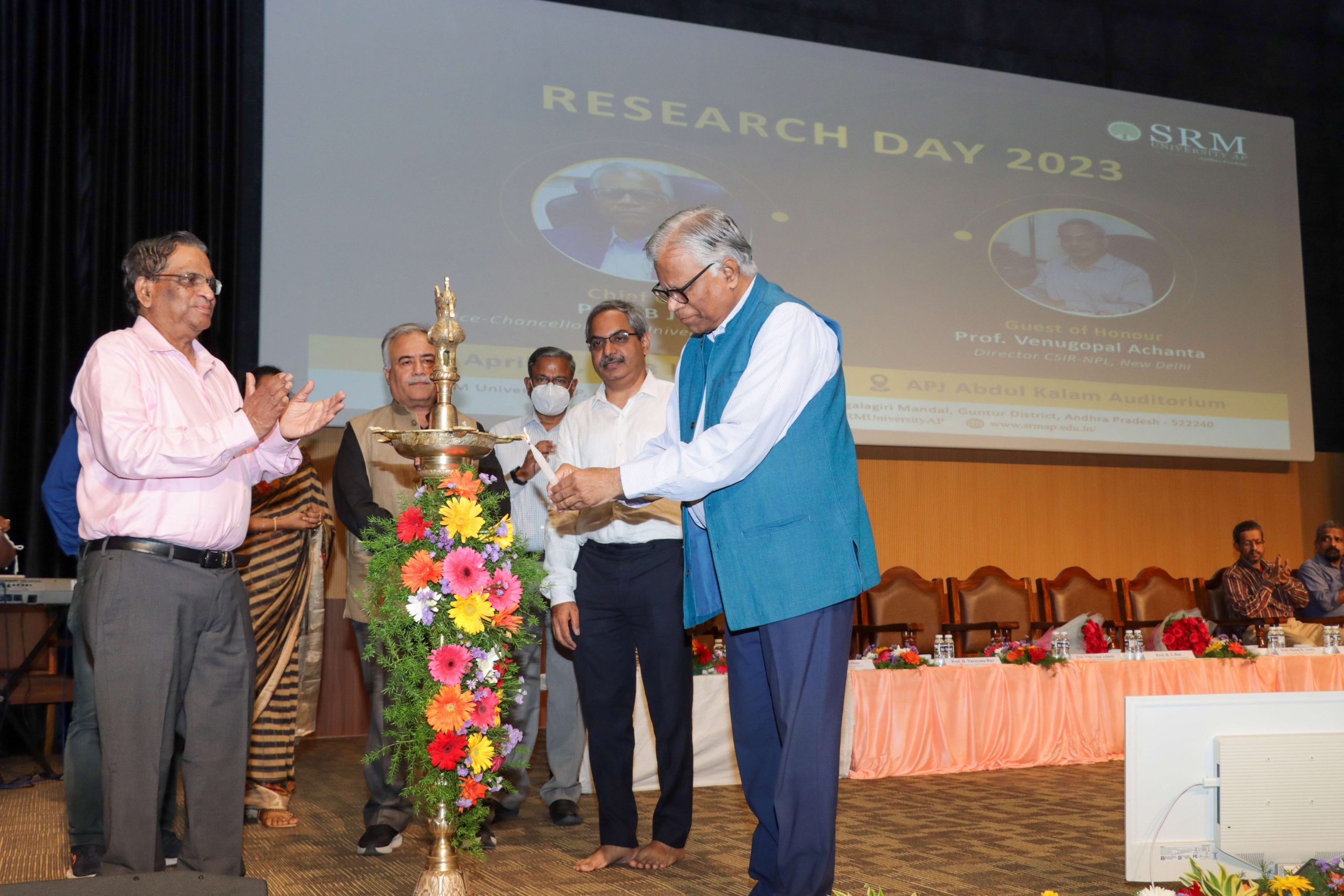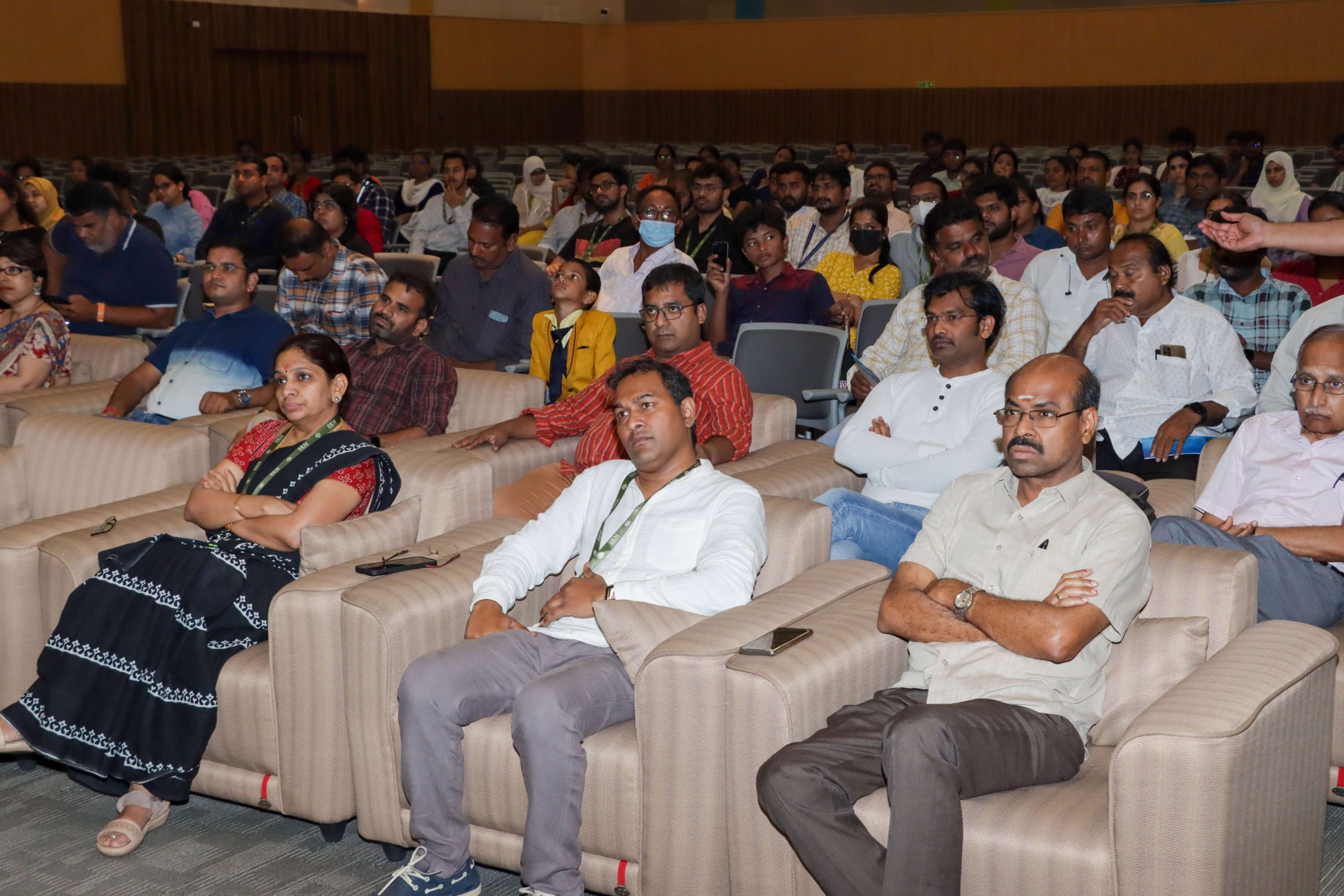Research News
- DST SERB-SURE Grants Funding for Mathematics Project May 24, 2023
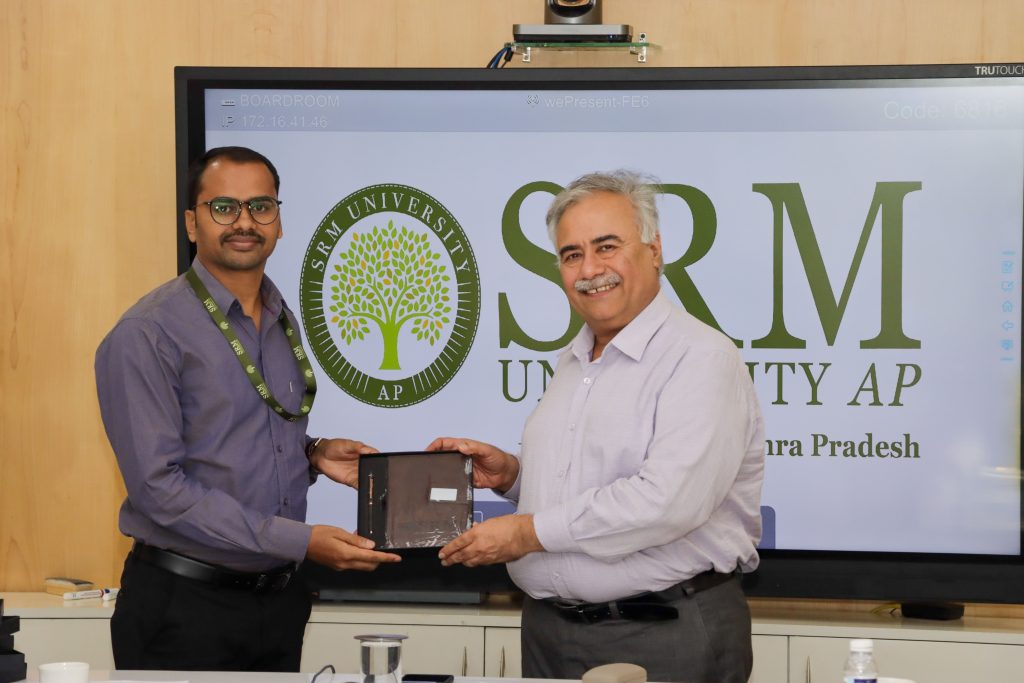
The Department of Mathematics is glad to announce that the project of Dr Sandeep Kumar Verma, Assistant Professor, titled “Investigation and development of wavelet transform and its applications in the framework of fractional Dunkl transform”, has been selected to be funded by DST, Govt. of India under SERB-SURE Scheme, securing an approved grant of 20.13 Lacs. Dr Sandeep Kumar Verma is the Principal Investigator of the project.
Title of the Project: Investigation and development of wavelet transform and its applications in the framework of fractional Dunkl transform
Approved Grant: 20.13 Lacs (As per university calculation)
Funded by: DST, Govt. of India under SERB-SURE Scheme
PI: Dr Sandeep Kumar Verma, Assistant Professor, Department of Mathematics
Project Summary: Dunkl operators are differential-difference operators associated with finite reflection groups in a Euclidean space. Dunkl transform is attracting widespread interest and giving us new perspectives on familiar topics from Harmonic Analysis and Partial Differential Equations. The fractional Dunkl transform (FRDT), which is introduced with one extra parameter, is the generalization of the well-known signal processing operations, such as the Fourier transform (FT), the fractional Fourier transform (FRFT), the Fresnel transform, Hankel transforms, fractional Hankel transforms, and the Dunkl transform. The FRDT will also find applications in the solution of optical systems, filter design, time-frequency analysis, and many others. The wavelet transforms (WT), which has had a growing importance in optics and signal processing, has been shown to be a successful tool for time-frequency analysis and image processing. It has found many applications in time-dependent frequency analysis of short-transient signals, data compression, optical correlators, sound analysis, representation of fractal aggregates, and many others.
The fractional wavelet transforms (FRWT) based on the fractional Fourier transform, which generalizes the classical wavelet transform, has proven potentially useful for signal processing, data compression, pattern recognition, and computer graphics. Thus, fractional wavelet transform gives more flexibility for time-frequency analysis than the usual wavelet transforms. As a generalization of the WT, a novel fractional Dunkl wavelet transform (FRDWT) can combine the advantages of the WT and the FRDT, i.e., it will be a linear transformation without cross-term interference and will be capable of providing multiresolution analysis and representing signals in the fractional domain. Simultaneously, compared to the Dunkl transforms, FRDT is more flexible for its one extra degree of freedom and can be used frequently in time-frequency analysis and non-stationary signal processing. Inspired by the fractional wavelet transform (FRWT), we introduce the concept of the (FRDWT), combining the idea of FRDT and WT. The proposed transform will not only inherit the advantages of multiresolution analysis of the WT, but also will have the capability of signal representations in the fractional Dunkl transform domain. Compared with the existing WT, the fractional Dunkl wavelet transform can offer signal representations in the time-fractional-frequency plane in the FRDT domain.
Continue reading → - SERB- SURE Grants: 10 projects worth 2.50 crores awarded to SRM AP May 16, 2023
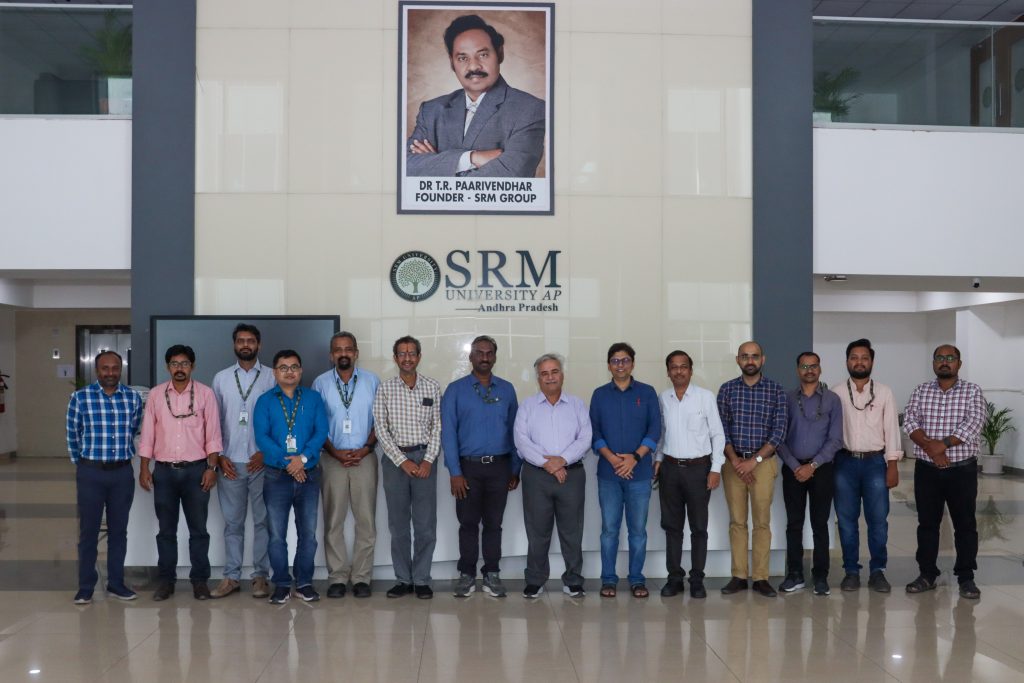
The faculty of SRM University-AP have been awarded 10 projects worth 2.50 crores from the Science and Engineering Research Board (SERB-SURE). Department of Science and Technology (DST) received a total of 2000 proposals, of which 466 were sanctioned. Among the 466 projects, 151 projects were awarded to Private Universities. Of the 151 projects approved to state private universities and colleges throughout India, the five-and-a-half-year young varsity was awarded 10 projects. 10 professors from various Science and Engineering Departments brought this incredible achievement to the university.
SERB-SURE is a research grant scheme initiated by the Science and Engineering Research Board (SERB) in India to provide financial support to young researchers in the early stages of their careers. The grants are intended to support research in basic and applied sciences, engineering, and technology and is typically granted for a period of three years.The SERB-SURE scheme is one of several initiatives by SERB to promote scientific research in India and support the development of a strong research community in the country.
“It is a milestone achievement that resonates with the University’s unparalleled commitment for excellence. We are striving towards research-intensive learning to build cutting-edge innovation for a transformative tomorrow”, commented Vice Chancellor, Prof. Manoj K Arora. The Executive Director-Research of SRM Group, Prof. Narayana Rao said that, “SRM University-AP has travailed hard to achieve the world-class scientific temperament that we now advocate, and this achievement is a testimonial recognition of all our efforts.” The prestigious grants were sanctioned to the faculty in the on-going domains of Quantum Kinetic Approach, Antimicrobial Resistance (AMR) Profiling and Changing of Hydroclimatic conditions in Bay of Bengal among 7 others.
Dean-SEAS, Prof. Ranjith Thapa said, “These research could be path-breaking and could offer a solution to many of the societal difficulties.” Prof. Jayaseelan Murugaiyan, Dr Sandeep Singh and Dr Pitchaiah Cherukuri of the Department of Biological Sciences; Dr Sabyasachi Chakrabortty, Dr V S Baswanth Oruganti of the Department of Chemistry; Dr Debabrata Pramanik, Dr Ravi Kumar and Dr Pankaj Bhalla of the Department of Physics ; Dr Sandeep Kumar Verma of the Department of Mathematics; Dr Uma Maheswar Arepalli of the Department of Civil Engineering; and Dr Kousik Das of the Department of Environmental Science and Engineering were awarded the grants.
Continue reading → - Two-Dimensional Transition Metal Oxide Layers and A method for Their Synthesis May 8, 2023
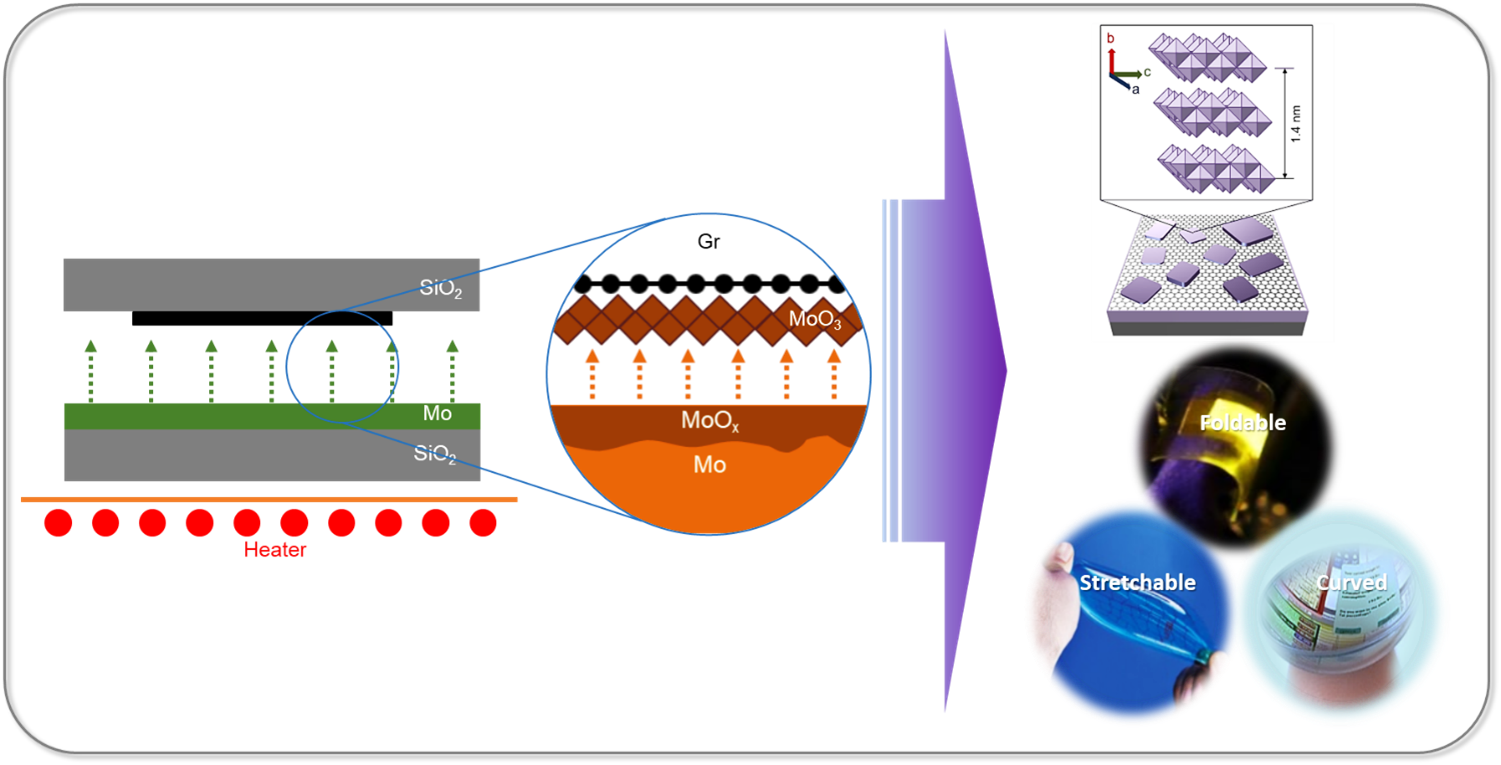 Researchers at the Department of Physics have successfully developed large-area ultra-thin 2D transition metal oxide (TMO) layers using a cost-effective and straightforward method through proximity evaporation under ambient conditions. Associate Professor Dr Jatis Kumar Dash and his students Shaik Md. Abzal, Kurapati Kalyan, and Sai Lakshmi Janga have secured a patent for their research in Two-Dimensional Transition Metal Oxide Layers and A method for their Synthesis (application no: 202241005220). They have integrated the 2D TMO layers with various other 2D materials to create nano-electronic devices. Their work demonstrates the immense potential of ultra-thin TMOs in 2D-material-based flexible electronics.
Researchers at the Department of Physics have successfully developed large-area ultra-thin 2D transition metal oxide (TMO) layers using a cost-effective and straightforward method through proximity evaporation under ambient conditions. Associate Professor Dr Jatis Kumar Dash and his students Shaik Md. Abzal, Kurapati Kalyan, and Sai Lakshmi Janga have secured a patent for their research in Two-Dimensional Transition Metal Oxide Layers and A method for their Synthesis (application no: 202241005220). They have integrated the 2D TMO layers with various other 2D materials to create nano-electronic devices. Their work demonstrates the immense potential of ultra-thin TMOs in 2D-material-based flexible electronics.Patent Background
The two-dimensional (2D) ultrathin hetero-stacked layers show unusual physiochemical properties when reduced to a few atoms in thickness. These 2D heterostructures offer significant benefits for next-generation devices. Firstly, their atomically thin 2D nanosheets provide a larger surface area due to the complete exposure of surface atoms. Secondly, edge sites in 2D nanosheets are chemically more reactive than their basal planes, and open gaps allow for the intercalation of electrolyte ions. In addition, the high mechanical strength and flexibility at atomic dimensions make them suitable for use in next-generation wearable electronics. However, growing and stacking 2D materials is challenging, and existing growth tools are complex and costly.
Future Prospects
2D materials are critical for making flexible, wearable, foldable and transparent self-powered smart electronic devices. The next generation smart electronic devices will be
Continue reading →
made of 2D materials heterostructures which will need less operating power, fewer materials consumption and will have ultimate scalability. - Delivered Lecture at the Two – day National Conference on Youth Development May 1, 2023
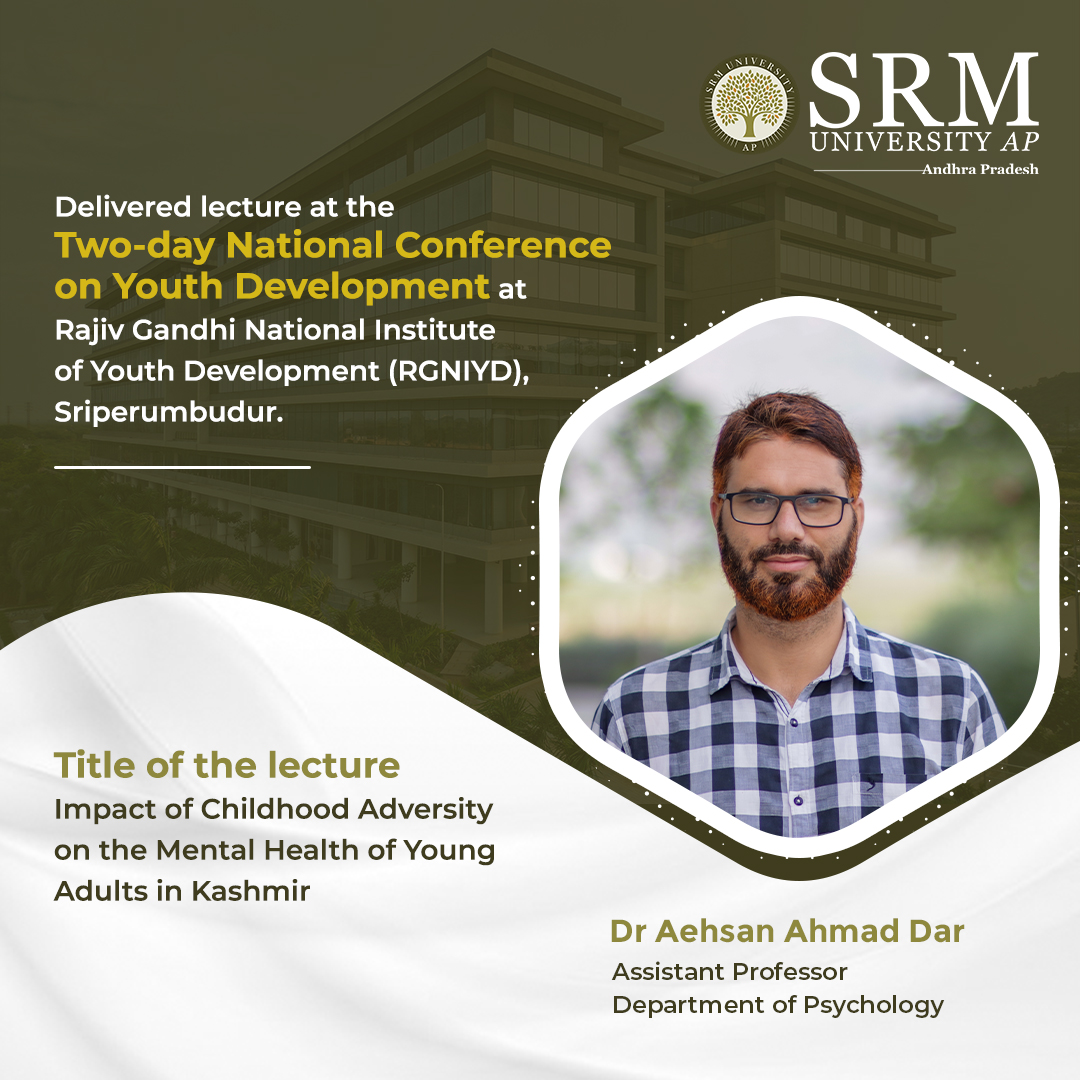 Dr Aehsan Ahmad Dar, Assistant Professor, Department of Psychology, delivered a lecture titled Impact of Childhood Adversity on the Mental Health of Young Adults in Kashmir at the Two – day National Conference on Youth Development held on March 24 and 25, 2023. Youth in the 21st Century: Prospects and Psychosocial Challenges was the theme of the conference, which was organised by the Department of Social Work and Department of Applied Psychology, Rajiv Gandhi National Institute of Youth Development (RGNIYD), Sriperumbudur, Tamil Nadu, in collaboration with ICMR – NIRT, Chennai.
Dr Aehsan Ahmad Dar, Assistant Professor, Department of Psychology, delivered a lecture titled Impact of Childhood Adversity on the Mental Health of Young Adults in Kashmir at the Two – day National Conference on Youth Development held on March 24 and 25, 2023. Youth in the 21st Century: Prospects and Psychosocial Challenges was the theme of the conference, which was organised by the Department of Social Work and Department of Applied Psychology, Rajiv Gandhi National Institute of Youth Development (RGNIYD), Sriperumbudur, Tamil Nadu, in collaboration with ICMR – NIRT, Chennai.Abstract of the Lecture
The study examines the impact of Adverse childhood experiences (ACEs) on mental health among young adults in Kashmir. A cross-sectional research design was followed to study the effect of ACEs on the mental health of Kashmiri youth by employing a multi-stage sampling method. Data were collected from 693 research participants who were studying in different colleges and universities in Kashmir, with the help of the Adverse Childhood Experiences scale and Mental Health Inventory (MHI-18). Findings revealed that various adversities during childhood, including psychological abuse, physical abuse, contact sexual abuse, household substance abuse, violent household treatment of mothers and fathers, household mental illness, and household criminal behaviour, had a significant impact on the mental health of Kashmiri youth in terms of increased anxiety, depression and loss of behavioural control and decreased positive affect.
Practical Implementation of the Findings
ACEs are traumatic events that individuals under 18 have experienced. Various individual, family, and community factors can affect a child’s likelihood of experiencing ACEs, and it causes long-term risks for mental health with the potential to carry over beyond the present generation. ACEs are linked to chronic health problems, mental illness, and adult risk-taking behaviours. There is a “dose-response relationship” between ACEs and health outcomes. Therefore, findings suggest advocating early targeted interventions to reduce ACEs and their impact on young people’s mental health in Kashmir. There is a need to design efficient measures, to enhance ACE resilience programs and ‘trauma-informed’ approaches to tackle the longer-term impact of ACEs on health and wellbeing.
Continue reading → - Research Day 2023: Anchoring an Innovative Research Culture May 1, 2023
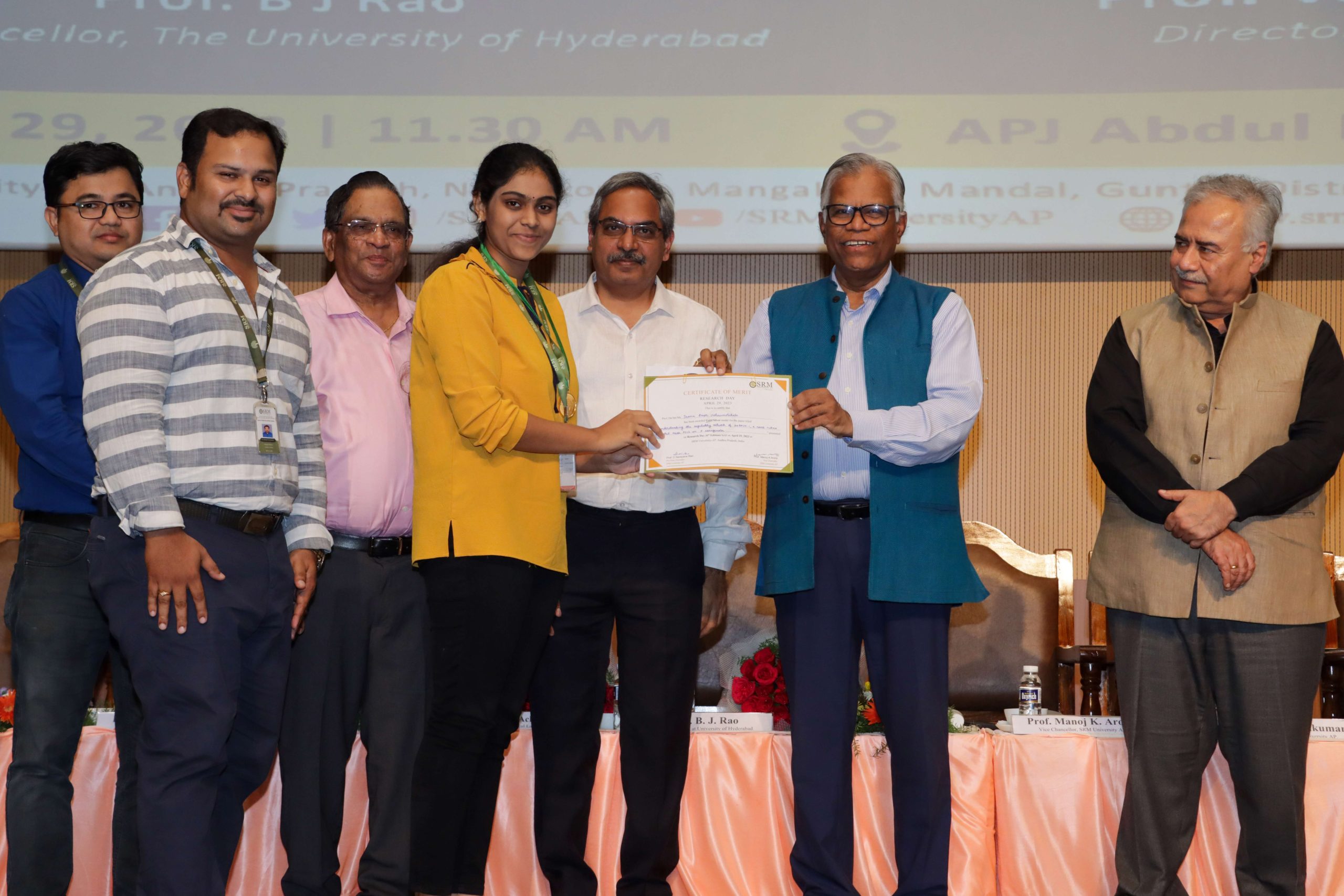 SRM University-AP observed the 6th edition of Research Day on Saturday, April 29, 2023. Research Day aims to foster the exchange of information across disciplines, encourages extensive research projects, and appreciates innovative efforts in research. Prof. B J Rao, Vice-Chancellor, University of Hyderabad, was the Chief Guest and Prof. Venugopal Achanta, Director, CSIR-National Physical Laboratory, Delhi, was the Guest of honour of the illustrious event held on the campus.
SRM University-AP observed the 6th edition of Research Day on Saturday, April 29, 2023. Research Day aims to foster the exchange of information across disciplines, encourages extensive research projects, and appreciates innovative efforts in research. Prof. B J Rao, Vice-Chancellor, University of Hyderabad, was the Chief Guest and Prof. Venugopal Achanta, Director, CSIR-National Physical Laboratory, Delhi, was the Guest of honour of the illustrious event held on the campus.‘‘There are multiple ways to look at the truth. It is the journey of truth that gives you interest in insights, and it is in that context that Research Day is significant. You are not just a human being when you do research; you become a thinker. When you become a thinker, you discover new things and find the actual purpose of your existence. That is the level of culture we need to generate in our educational ecosystem,’’ stated Prof. B J Rao, Chief Guest of the event. He proceeded to explain why education must be an open process of learning and how it happens only by diffusion. ‘‘Scientific ethics is a big challenge in the country. Whatever I do, it is always looked under the microscope. It will take a longer time. It doesn’t matter. Are you not sure? Do one more experiment,’’ said the Guest of honour Prof. Venugopal Achanta.
The 6th edition of Research Day, for the first time, invited researchers from all SRM Group of Educational Institutions, AIIMS Mangalagiri, Acharya Nagarjuna University, Acharya N G Ranga Agricultural University, and Vignan University. It was an excellent opportunity for research enthusiasts to exchange and exhibit their ideas on research. UG, PG, and PhD students presented their research abstracts which is the culmination of innovative ideas and a sign of continuous contributions to research advancements on April 26, 2023. The various themes covered diverse topics such as AI, Machine learning, Cyber Security, Electric Vehicle, Renewal and Nonrenewal energy, Health Care Technologies, Image Processing and Computer Vision, Communication and Digital technologies, Robotics, VLSI and Embedded Systems, Drone Technologies, and Geoscience etc.
‘‘During the next five years, besides fundamental research, our focus will be on industrial research, research commercialisation, prototype and product development, and technology transfers,’’ said Prof. Manoj K Arora, Vice Chancellor, SRM University-AP, while addressing the gathering. ‘‘We have conceptualised Research Day to provide an opportunity for the students to get a comprehensive knowledge of the diverse research activities being carried out in the university. It is also a chance for enthusiastic students to showcase their research work,’’ added Prof. D Narayana Rao, Pro-vice-chancellor, SRM University-AP.
As part of Research Day, students and research scholars were advised to submit their research abstracts. Over 350 abstracts were received. 181 abstracts from the UG/PG category and 110 abstracts from the PhD category were accepted. A special issue of the research abstracts booklet comprising all selected abstracts was unveiled during the event. Gold and Silver medals and certificates have been awarded to the winners for their research work in various thematic areas. The potential abstracts will be converted into full papers, which will be submitted further to reputed conferences and journal papers.
Continue reading → - Agricultural Utility Vehicle: Patent Granted to Inventors from the Department of EEE April 19, 2023
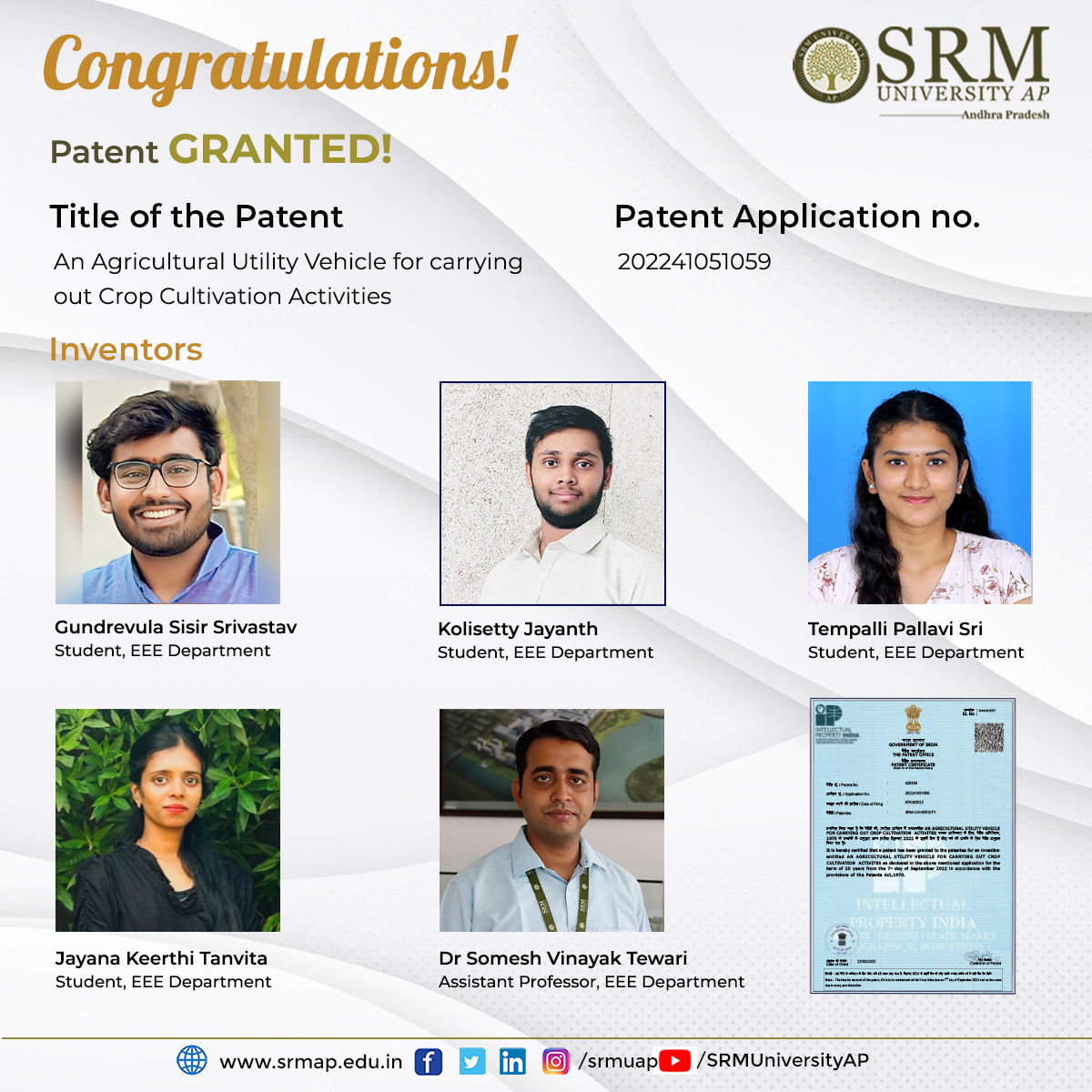 Conventional agricultural utility vehicles used for crop cultivation involve complex operations such as ploughing and seeding, require trained personnel, and are expensive and not affordable to many farmers, especially in developing countries. Thus, there is a need for an agricultural utility vehicle for carrying out crop cultivation activities that alleviate the drawbacks of conventional practices.
Conventional agricultural utility vehicles used for crop cultivation involve complex operations such as ploughing and seeding, require trained personnel, and are expensive and not affordable to many farmers, especially in developing countries. Thus, there is a need for an agricultural utility vehicle for carrying out crop cultivation activities that alleviate the drawbacks of conventional practices.Researchers at the Department of Electrical and Electronics Engineering have been granted a patent for an invention entitled An Agricultural Utility Vehicle for Crop Cultivation Activities (Application number 202241051059). Assistant Professor Dr Somesh Vinayak Tewari and his students Gundrevula Sisir Srivastav, Kolisetty Jayanth, Tempalli Pallavi Sri, and Jayana Keerthi Tanvita have accomplished this milestone through their dedicated research.
Abstract
The present disclosure discloses an agricultural utility vehicle (1000) for carrying out crop cultivation activities comprising a framed structure (200) having wheels configured to be driven in an open plot of land. An agricultural implement (400) is configured to be attached to the vehicle. An electric drive system (100) is configured to drive the framed structure, and a battery (300) is coupled to the electric drive system to provide power.
Continue reading → - Presented Paper at the 32nd International Annual Convention of the National Academy of Psychology April 3, 2023
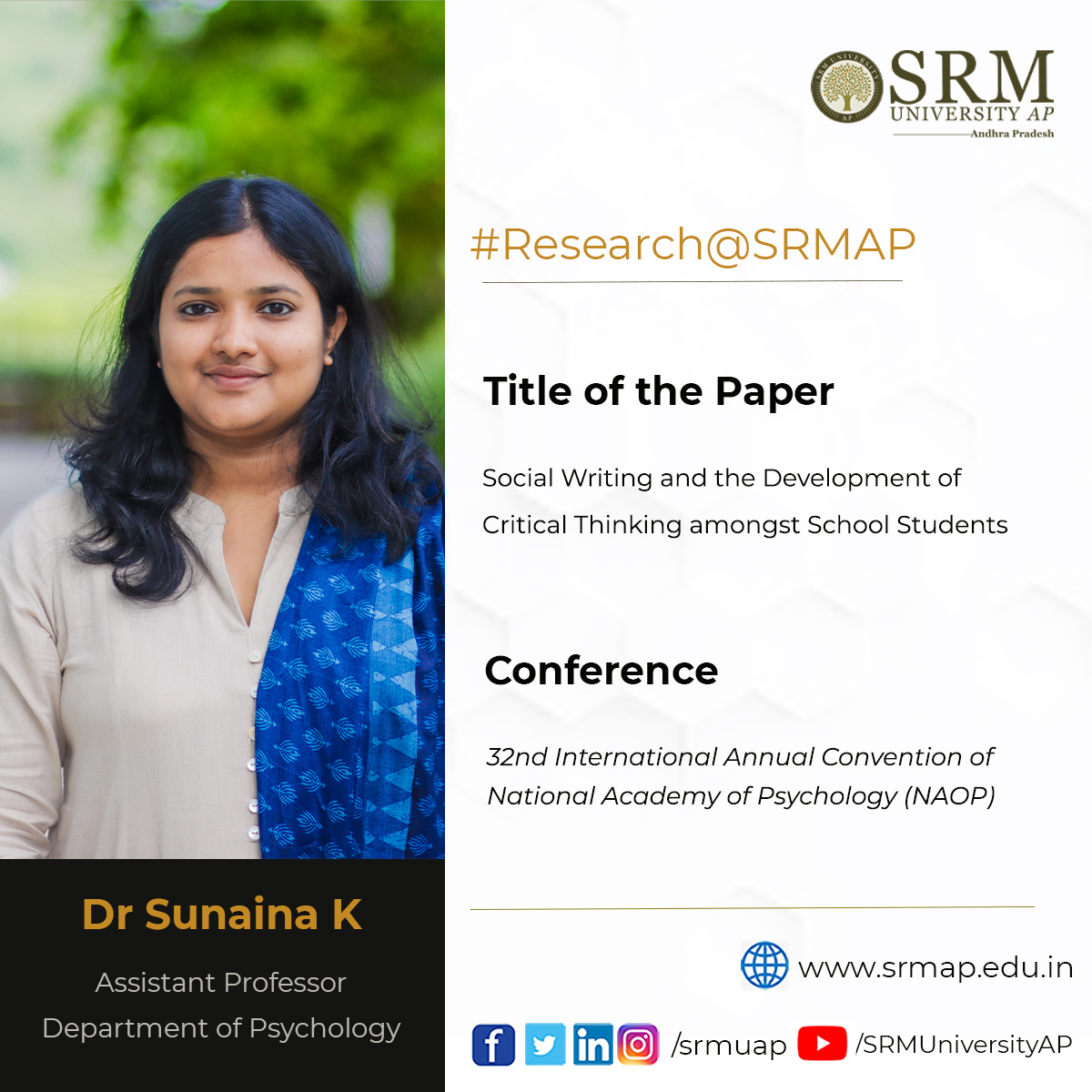 The Annual Conventions of the National Academy of Psychology (NAOP) aim to provide a platform to present, discuss, and debate issues that confront individuals, groups, and communities in this fast-changing world. Dr Sunaina K, Assistant Professor of the Department of Psychology, has presented a paper titled Social Writing and the Development of Critical Thinking amongst School Students at the 32nd International Annual Convention of the National Academy of Psychology (NAOP), held at Ahmedabad University, Gujarat, from March 3 to 5, 2023.
The Annual Conventions of the National Academy of Psychology (NAOP) aim to provide a platform to present, discuss, and debate issues that confront individuals, groups, and communities in this fast-changing world. Dr Sunaina K, Assistant Professor of the Department of Psychology, has presented a paper titled Social Writing and the Development of Critical Thinking amongst School Students at the 32nd International Annual Convention of the National Academy of Psychology (NAOP), held at Ahmedabad University, Gujarat, from March 3 to 5, 2023.Abstract
This study attempted to examine the texts, contexts and voices of young adolescents in social writing activities in schools and how thinking is constructed through the same activities. An intervention study of one-year duration on social writing, based on a longitudinal quasi-experimental design, has been conducted with 15 students in a government school in Kozhikode district in Kerala. The intervention programme was conducted with the help of a module of writing activities prepared by the researcher by using the Vygotskian pedagogic ideas. Each writing session was preceded by a dialogue session between the adult member and the students.
The study employed Thematic Content Analysis as the method of data analysis. The thematic analysis of the mediated learning of social writing unfolds the dialectical interplay between the human mediators, cultural tools and the motives for developing critical thinking skills in the students. From the analysis of the pattern of appearing ‘self-reflections’, a domain of critical thinking (Barnette, 1997), it can be said that interactive participation in the dialogue session enhances participation in the writing activities with the involvement of self. Active participation in the dialogue session helps the students gather maximum information on the theme of dialogues (collection of everyday concepts) and also makes some generalisations. These generalised ideas are transforming into conceptualised thoughts (thinking in ‘scientific concepts’) when the students go through in a deliberate, systematic thinking process while writing. This conceptualisation of ideas, visible in students’ texts, is the base of the critical thinking that is getting reflected in their writings and further helps them in critical reasoning, self-reflection and thinking about critical actions while writing.
Continue reading → - An appraisal of India’s comparative advantage in information technology exports April 3, 2023
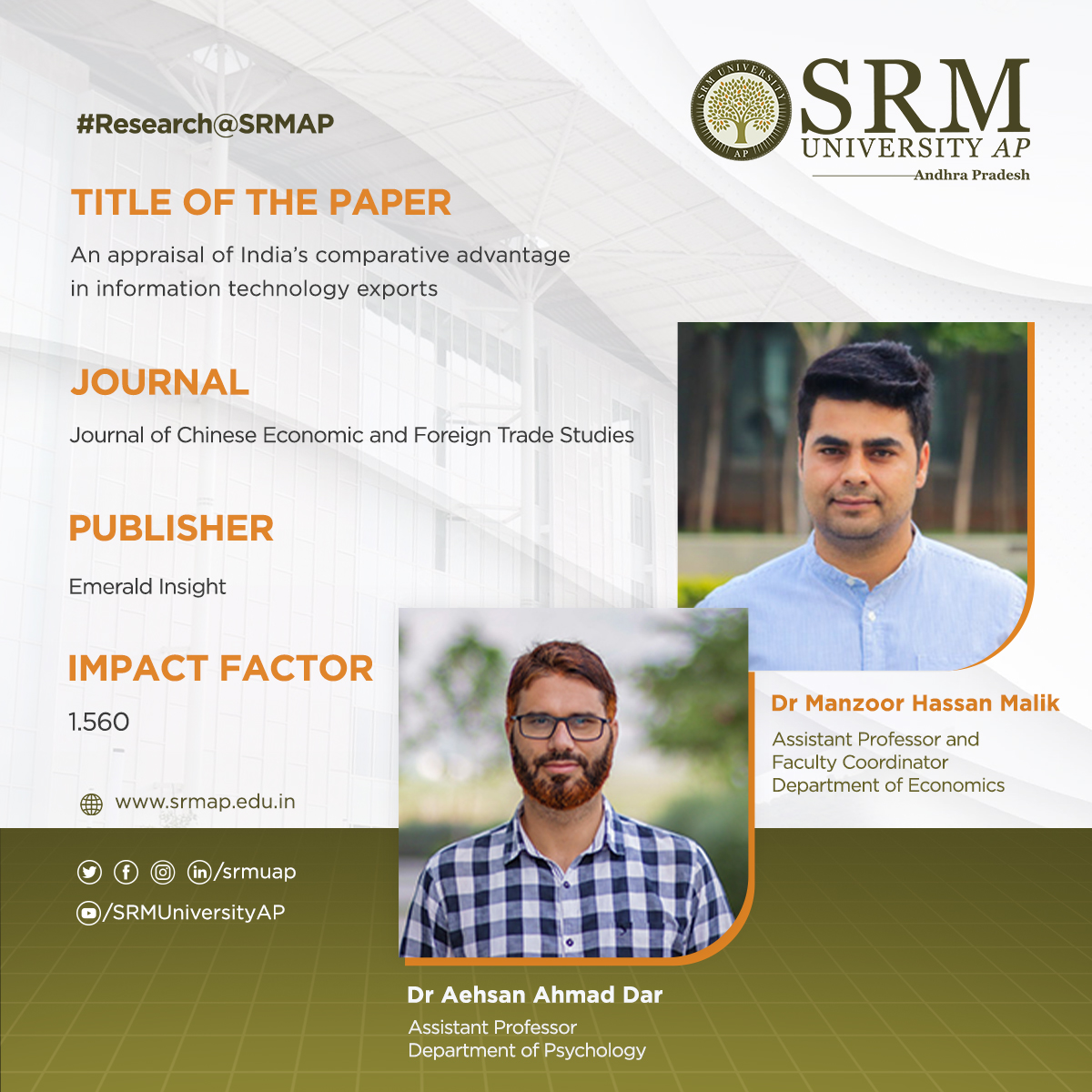 Researchers of the School of Liberal Arts and Social Sciences have worked on India’s comparative advantage in information technology exports with competing developing nations, including China, the Philippines, Malaysia, and Brazil. The latest paper published by Assistant Professor Dr Manzoor Hassan Malik, Department of Economics and Assistant Professor Dr Aehsan Ahmad Dar, Department of Psychology, has implications for attaining sustainability in IT export growth. It is suggested that policies are directed at enhancing the overall performance of the IT sector. The novelty of the present study lies in the estimation of India’s competitiveness in IT exports in relation to the group of reference countries, namely China, the Philippines, Malaysia, and Brazil. With its policy recommendations, this research is helping to shape the sustainability of the IT sector.
Researchers of the School of Liberal Arts and Social Sciences have worked on India’s comparative advantage in information technology exports with competing developing nations, including China, the Philippines, Malaysia, and Brazil. The latest paper published by Assistant Professor Dr Manzoor Hassan Malik, Department of Economics and Assistant Professor Dr Aehsan Ahmad Dar, Department of Psychology, has implications for attaining sustainability in IT export growth. It is suggested that policies are directed at enhancing the overall performance of the IT sector. The novelty of the present study lies in the estimation of India’s competitiveness in IT exports in relation to the group of reference countries, namely China, the Philippines, Malaysia, and Brazil. With its policy recommendations, this research is helping to shape the sustainability of the IT sector.The paper titled An appraisal of India’s comparative advantage in information technology exports was published in the Journal of Chinese Economic and Foreign Trade Studies with an impact factor of 1.560.
Abstract
The purpose of this study is to estimate revealed comparative advantage and Normalised Revealed Comparative Advantage (NRCA) indices of India’s Computer and Information Services (CIS) export competitiveness about Information Technology (IT) competing developing nations, such as China, Philippines, Malaysia and Brazil. Using annual data of total exports for CIS, transportation (TNS), travel (TVL) and insurance (INS) services under service categories of the balance of payment, the present study estimates the pattern of Comparative Advantage (CA) in India’s CIS exports with respect to IT competing developing nations such as China, Philippines, Malaysia and Brazil from 2000 to 2018. The choice of the study period is determined by the availability of consistent data on IT service exports of these nations. The study also estimates the export position of CIS export in comparison to India’s traditionally strong commercial services export of TNS, TVL and INS during the study period. Both indices showed that India had a strong CA in CIS compared to the selected nations, indicating India’s relative export performance to be stronger than that of China, Malaysia, the Philippines, and Brazil. The cross-service index showed that India’s relative specialisation level in CIS with respect to the world’s average specialisation level was stronger than its relative specialisation level in TNS, TVL and INS services. Furthermore, The NRCA cross-nation index showed that India’s NRCA index score has been declining since 2010 with respect to these nations, which implied a decline in the competitiveness of CIS. On the other hand, NRCA has increased in the case of the Philippines, Malaysia and Brazil for most of the period post-2010.
Continue reading → - Koecher-Maass Series have Infinitely Many Critical Zeros March 24, 2023
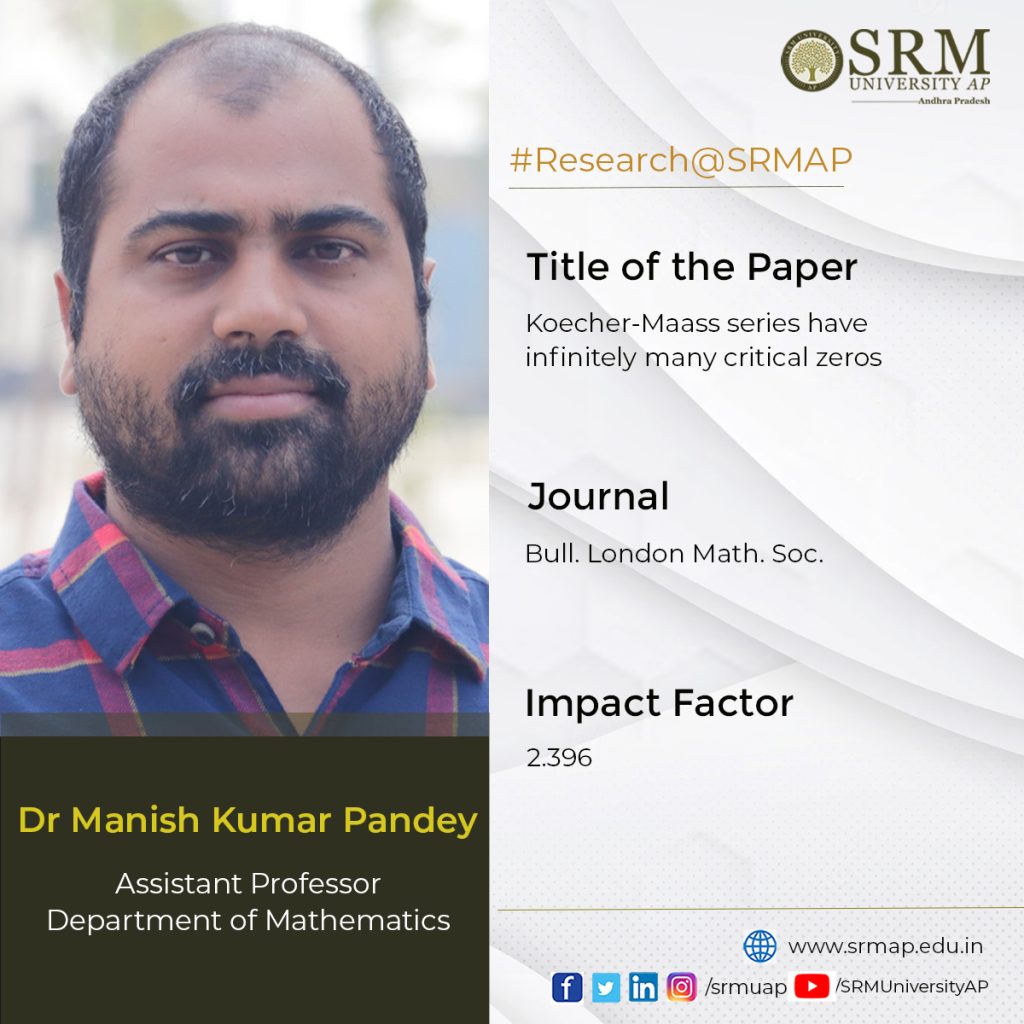
Dr Manish Kumar Pandey, Assistant Professor, Department of Mathematics, has published a paper titled, “Koecher–Maass series have infinitely many critical zeros” in the journal Bull. London Math. Soc. having an Impact Factor of 2.396.
Abstract
The article studies the zeros of the Koecher-Maass series associated with a Siegel cusp form of degree 2. It is proved that the Koecher-Maass series associated with a Siegel cusp form has infinitely many zeros on the critical line.
Practical implementation
It is well known that zeros of the Riemann zeta function have connections with prime numbers. In a similar fashion, one can state the behaviour of the coefficients of such series at primes. These are results of pure mathematical flavour and their immediate application will take time.
Collaborations
-
- Dr Jaban Meher, National Institute of Science Education and Research (NISER), Bhubaneshwar
- Dr Karamdeo Shankhadhar, Indian Institutes of Science Education and Research (IISER), Bhopal
-
- Maximising Electrochemical NH3 Production March 21, 2023
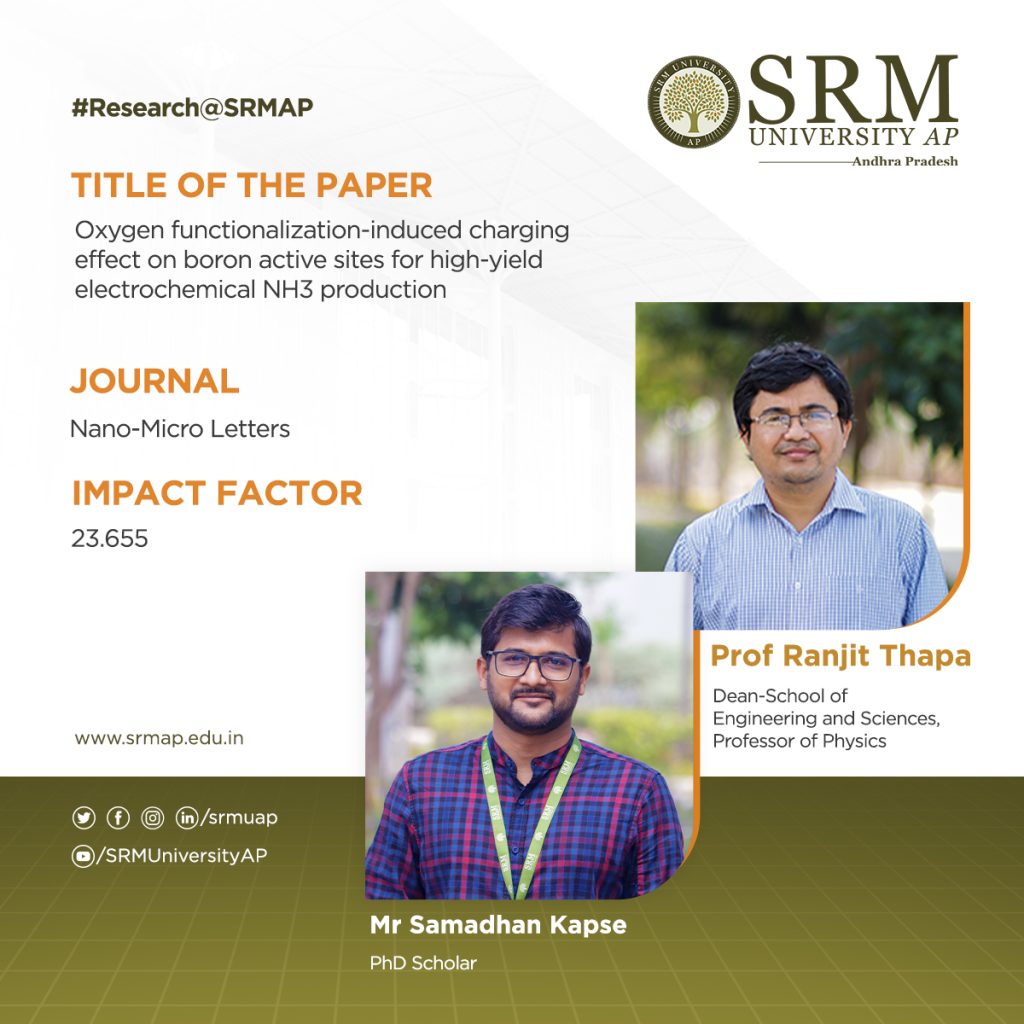
Significant measures have been undertaken to synthesise ammonia proficiently, the future renewable energy fuel for its wide range of applications in various sectors. On this account, a research paper titled “Oxygen functionalization-induced charging effect on boron active sites for high-yield electrochemical NH3 production” has been published by Prof. Ranjit Thapa, Professor, Department of Physics and his research scholar Mr Samadhan Kapse in the journal Nano-Micro Letters having an impact factor of 23.655.
Abstract
Ammonia has been recognized as the future renewable energy fuel because of its wide-ranging applications in H2 storage and transportation sector. In order to avoid the environmentally hazardous Haber–Bosch process, recently, the third-generation ambient ammonia synthesis has drawn phenomenal attention and thus tremendous efforts are devoted to developing efficient electrocatalysts that would circumvent the bottlenecks of the electrochemical nitrogen reduction reaction (NRR) like competitive hydrogen evolution reaction, poor selectivity of N2 on the catalyst surface. Herein, we report the synthesis of an oxygen-functionalised boron carbonitride matrix via a two-step pyrolysis technique. The conductive BNCO(1000) architecture, the compatibility of B-2pz orbital with the N-2pz orbital and the charging effect over B due to the C and O edge-atoms in a pentagon altogether facilitate N2 adsorption on the B edge-active sites. The optimum electrolyte acidity with 0.1 M HCl and the lowered anion crowding effect aid the protonation steps of NRR via an associative alternating pathway, which gives a sufficiently high yield of ammonia (211.5 μgh−1 mgcat−1) on the optimized BNCO(1000) catalyst with a Faradaic efficiency of 34.7% at −0.1 V vs RHE. This work thus offers a cost-effective electrode material and provides the contemporary idea about reinforcing the charging effect over the secured active sites for NRR by selectively choosing the electrolyte anions and functionalizing the active edges of the BNCO(1000) catalyst.
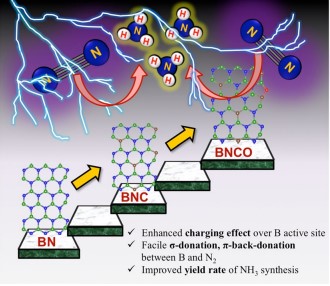
A brief summary of the research in layman’s terms
In summary, this work displayed the significant role of O and C doping within BN architecture to promote NRR on the edge B sites via an associative alternating mechanism. The gradual formation of the ideal structure was systematically studied by means of XPS and the electronic properties was investigated from NEXAFS. A greater impact was found on the charging effect of B centres due to O-functionalized edges that induced a greater charge density from B to the adsorbed N2, overcoming the potential determining steps for NRR. This work simultaneously highlighted the importance of the choice of electrolyte, where in 0.1 M HCl our catalyst BNCO(1000) yielded 211.5 μg h−1mgcat−1 of ammonia at −0.1 V vs RHE with a FE of 34.7%. It was experimentally found and theoretically supported that the bulky anions in H2SO4 and H3PO4 blocked the B active sites by a Lewis acid-base interaction between the B sites and the O ends of the anions, hence not suitable for this class of materials. Thus, the present work offered an overall idea of catalyst designing and the medium to retain a high and consistent NRR performance.
Social implications of the research
Nitrogen reduction reaction (NRR) performed electrochemically is regarded as a green and legitimate approach to ammonia synthesis and it has been intrinsically brought into the limelight by the worldwide research community, not only because of the immense use of ammonia in the agriculture and transportation sector but also due to urge to resolve the fallacies associated with the process. Primarily, the eternal problem persisting with NRR is the predominance of the combative hydrogen evolution reaction (HER) at the same potential range, which overpowers NRR over most of the catalyst surfaces, resulting in poor yield and Faradaic efficiency (FE) of ammonia production. Researchers thus majorly focus on varied catalyst development, which includes several strategies: (a) Selectivity of elements that would prefer binding with N2 over protons, (b) Blocking the HER active sites, (c) Phase-selective material designing, inhibiting HER at the active surface, (d) interface-engineering that would deviate the HER pathway inducing better Faradaic efficiency for NRR. Although either 1st-row transition metals or semimetals are regarded as more suitable candidates for NRR, a metal-free approach is rather preferred for the cost-effectiveness and simplicity of the process. Boron (B)-based electrocatalyst in this respect can act as a strong contender. The research also posits that Density functional theory is useful for the molecular level understanding to unveil the performance of different catalytic reactions.
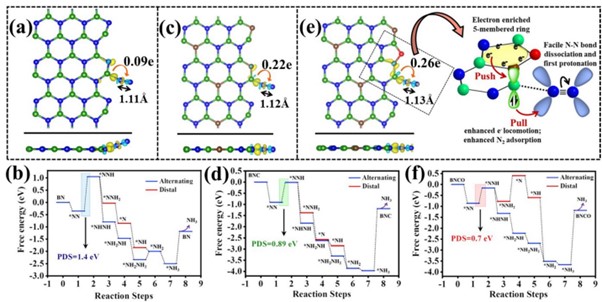
Collaborations
- Ms Ashmita Biswas, Institute of Nano Science and Technology (INST), Sector-81, Mohali, Punjab 140306, India
- Mr Ramendra Sundar Dey, Institute of Nano Science and Technology (INST), Sector-81, Mohali, Punjab 140306, India


